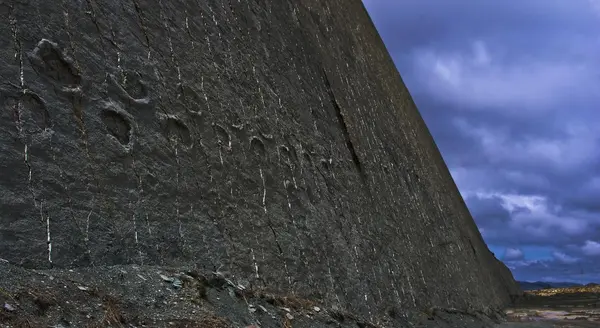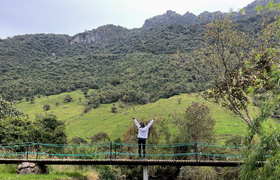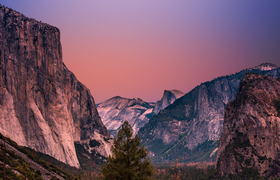
Dino tales: the story behind Cal Orck'o
Dig into how a 300-foot limestone wall in Bolivia became covered in 400 distinct dinosaur trails
Travel a short distance from downtown Sucre, Bolivia and you'll find a place to realize all your childhood Jurassic Park fantasies: Cal Orck’o, a 100m (328 ft) dinosaur wall covered in 5,000+ dinosaur footprints.
Made of limestone, Cal Orck’o is more than 1.5km (0.9 mi) long and has 462 distinct trails made by eight different dinosaur species. These include footprints made by a baby T-rex nicknamed “Johnny Walker”: its footprints trace 366m (1,200 ft). And no, dinosaurs didn’t walk on walls: due to tectonic activity the limestone surface that once laid horizontally was pushed up into an imposing rock wall.

Opt to see Cal Orck'o with free time on: Bolivia to Peru: Lakes, Salt Flats & Machu Picchu
All of the tracks were formed during the Maastrichtian age of the Cretaceous period in the Mesozoic era, which, for non-dino buffs, took place approximately 68 million years ago. The footprints were first discovered in 1985 by miners, but their importance wasn’t fully realized until the mid- to late-1990s when a research team led by Swiss paleontologist Christian Meyer arrived to research the wall.
Parque Cretacico, which opened in the vicinity in 2006, features 24 dinosaur replicas as well as a 46m (150 ft) high platform from which Cal Orck’o can be viewed. The site itself was closed off to tourism from 2008 to 2016 due to damage to the site; now there are guided tours available that take tourists within a few metres of the wall.
The excellent preservation of the dinosaur tracks on Cal Orck’o is due to the climate fluctuations that would have taken place in Sucre after the footprints were set. According to a 2011 piece in The Guardian, dinosaurs stepped onto a soft shoreline, and the imprints they made were solidified by drought. Later, wet weather returned, and the prints were sealed beneath mud and sediment. This pattern — drought giving way to wet weather — repeated seven times between the Cretaceous period and today.

Unfortunately, Cal Orck’o’s location — in a limestone quarry owned by Fancesa, a Bolivian cement company — means its tracks have been damaged by mining work and erosion. The government of Bolivia attempted to have Cal Orck’o designated as a UNESCO World Heritage site in 2009, which would have provided USD$8-million in funding to help preserve the dinosaur tracks. However, the designation failed when Fancesa opposed the application. In the meantime, visitors are still able to see this massive, diverse selection of dinosaur footprints — hopefully, not only for a limited time.
Want to see Cal Orck'o for yourself? You can use your free time to get there on a number of trips to Bolivia that take you from the salt flats to Sucre and beyond. Rawr!




